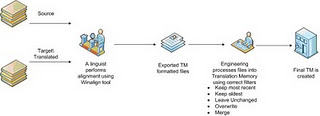There are 3 ways we can help clients consolidate their technical translation memories:
1. Using segmented translated files (Bilingual file) – It is a very simple process, which consists of feeding a translation memory with text segments from translated files provided by the client. In case you have changed the source text of one or more document translation segments, a program we use, Trados Translator’s Workbench automatically creates a new translation entry. If not, the translation memory is left unchanged.

2. Merging TMs from different vendors – Just open Trados Workbench and import “exported TMs” accordingly. There are filters set depending on either client request or the files’ linguistic condition and volume. The most common filters used are:
- Keep most recent – means that Translator’s Workbench compares the creation dates of the existing translation and the external translation and keeps the most recently created unit.
- Keep oldest – it has the opposite effect – the older translation is kept.
- Leave unchanged – imported translated segment is always rejected, whenever it is already in the translation memory.
- Overwrite – means that Translator’s Workbench always imports the external translation and overwrites the existing translation.
Merge – means that if attributes and text fields are the only difference between the imported target segment and the target segment of the translation unit in the translation memory, they are merged with the attributes and text fields of the translation unit in the memory. If the translation memory allows multiple technical translations of the same source segment, Translator’s Workbench creates a new translation unit with a different target segment.
3. Aligning files – This is the most expensive due to the amount of labor and people involved. A text alignment tool (Trados Winalign) can be used to create a translation memory from previously translated texts (that were not done in a TM environment). It is a process of creating equivalents, segment by segment, between a source text and the corresponding translated text. The resulting “table of equivalents” will then be imported to a translation memory.
Alignment makes it possible to use previous translations that were done without translation support software. Even with the help of Trados Winalign, alignment operations nevertheless require a considerable amount of manual intervention. A linguist from our technical translation services is involved to make sure the segments are aligned correctly, and the use of filters might also be necessary to convert files into a translation memory-friendly format.
Excel Translations will help you understand and implement the most appropriate technical translation process to give you the best-consolidated translation memory to leverage going forward.
